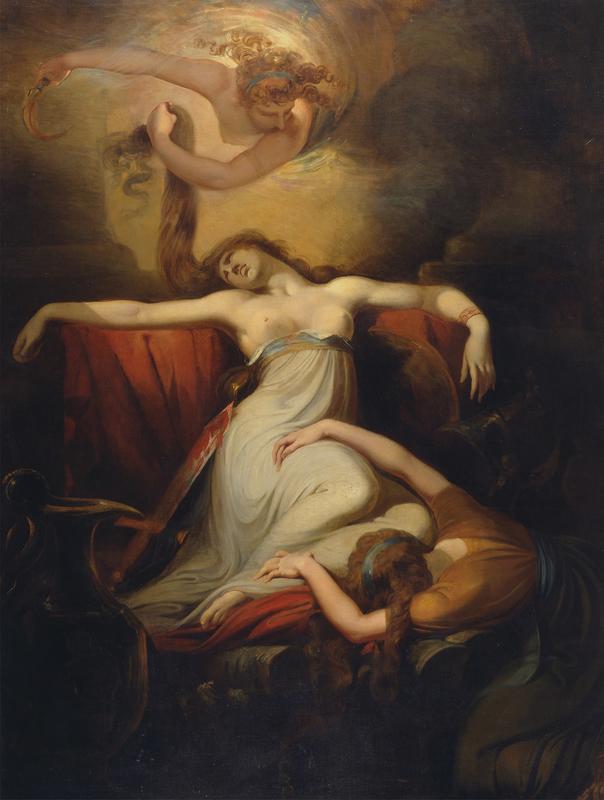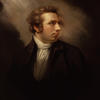More about Dido

Contributor
According to legend, Dido used her resourcefulness to found the ancient Phoenecian city-state of Carthage, going on to become its first queen.
After her greedy brother Pygmalion (who, incidentally, fell in love with a statue, so he definitely had some issues) murdered her husband Acerbas in hopes of stealing his wealth, Dido fled her home city to start a new life on the coast of North Africa. There she met a local king, Iarbas, who, trying to be clever, agreed to sell her as much land for herself and her people as could be covered by an oxhide. But Dido, who actually was very clever, was able to get around the king’s stinginess by cutting up the oxhide into narrow strips and encircling a hill with them, thus securing a site to found her new city on.
As suggested by the bloody sword laid beside Dido’s body (which, bizarrely, doesn’t seem to be wounded...Fuseli must have thought a gash in her side would spoil the effect of her sexy pose) things took a turn for the worse. According to early Greek sources, King Iarbas wouldn’t stop hounding poor Dido for her hand in marriage after he saw her cunning trick with the oxhide, which seems to have impressed him. Dido wasn’t interested—she was still grieving her dead husband—but Iarbas wouldn’t take no for an answer, and so she decided to stage an elaborate ceremony which she said was to release herself from the sacred promise of fidelity she’d made to her husband. At this ceremony, she built a funeral pyre and threw herself upon it, killing herself out of sheer desperation to escape Iarbas’s unwanted advances. All because he never learned how to pick up on social cues. Wonderful.
This version of the story, delightful as it is, isn’t the one that Fuseli chose to depict here. The most famous portrayal of Dido was in Virgil’s Aeneid. In his epic poem, the Roman poet transformed her from an independent queen who died to escape an unwanted marriage into a woman who died for the love of the poem’s hero, Aeneas. According to this revised version of the myth (which almost certainly didn’t happen, since the historical Aeneas likely died several hundred years before Dido was born), Aeneas met Dido while he was journeying from Troy to Lavinium, and the two fell madly in love —as soon as Dido, who initially wasn’t interested, was shot by an arrow from Cupid. But Aeneas’s fate, which was to found Rome, had already been ordained, and he eventually left Dido to fulfill it. Devastated by the loss of her lover, Dido killed herself by falling on Aeneas’s sword and building a funeral pyre, hoping that Aeneas would see the blazing flames from his vantage point at sea.
The story of Dido has been told and retold countless times throughout history. But, despite this painting’s well-trodden subject matter, it was still received with a fair amount of controversy. In 1781, when Dido was first exhibited, Fuseli hadn’t quite made it as an artist yet and was strapped for cash. Desperate, he decided it was time for a potentially career-making publicity stunt—one that involved a complete and total betrayal of his friend Sir Joshua Reynolds, whose studio he’d visited frequently enough to see that he was working on his own Dido painting, which he planned to show at the Royal Academy exhibition of 1781. The first step in Fuseli’s shameless plan was to tell everyone that not only was Reynolds working on the painting, but that the work wasn’t going well: “Sir Joshua...is busy with Dido again,” Fuseli gossiped in a letter he wrote in 1780, “the Same in every respect as the first but less promising in point of execution; he himself begins to think he has failed.” Shortly after spreading these scathing rumors about his so-called friend, Fuseli began a painting identical in subject matter (though not in style) to Reynolds’s Dido, planning not only to compete with his painting for attention at the 1781 exhibition, but also, hopefully, to draw attention to flaws in Reynolds’s technique by juxtaposing the two. Fuseli even went so far as to make his painting slightly bigger than Reynolds’, ensuring that it would be competing for onlookers’ attention in the exhibition hall.
The two Didos both feature the same moment just after Dido’s death. Her sister Anna is crumpled at her feet, too overcome with grief to cut off a lock of Dido’s hair, which would free her soul to journey to the underworld. The goddess Juno has sent Iris, personification of rainbows and messenger of the gods, to do it instead, and here she hovers over Dido’s head in a rainbow-y swirl of light, holding a scythe. Both paintings show Dido atop her funeral pyre surrounded by black a cloud of black smoke—and Dido’s boobs are unnecessarily out in both of them too, possibly because Fuseli wanted to make extra sure that his painting wasn’t overshadowed by the eye-catching nudity in Reynolds’.
Though it’s unclear how much the Dido controversy actually helped get Fuseli’s career off the ground, it certainly got people talking about him. Just as Fuseli had hoped, critics couldn’t get enough of the drama, and newspapers were filled with articles comparing the two paintings after the exhibition. One anonymous reviewer even went so far as to write a series of letters to the editor in which they ripped Reynolds’ technique to shreds before revealing that, while Fuseli had read the Aeneid in its original Latin, Reynolds had (gasp!) based his picture on an English translation, which of course meant it couldn’t possibly be as good. Perhaps the anonymous reviewer was Fuseli himself, getting in one last jab at Reynolds while he still had the chance?
Sources
- Brenneman, David A. “Self -Promotion and the Sublime: Fuseli’s ‘Dido on the Funeral Pyre.’” Huntington Library Quarterly 62, no. 1 (1999): 68-87.
- Desmond, Marilynn. Reading Dido: Gender, Textuality, and the Medieval Aeneid. Minneapolis: University of Minnesota Press, 1994.
- Edgeworth, R. J.“The Death of Dido.” The Classical Journal 72, no. 2 (1977): 129-133.
- Gill, N.S. “The Story of Dido, Queen of Ancient Carthage.” ThoughtCo, September 5, 2019. https://www.thoughtco.com/dido-queen-of-carthage-116949.
- Jargalsaikhan, Bolor. “Story of Pygmalion and Galatea by Sir Edward Burne-Jones.” Daily Art Magazine, November 19, 2020. https://www.dailyartmagazine.com/story-of-pygmalion- and-galatea/.
- “Sir Joshua Reynolds (1723-92): The Death of Dido c. 1775-81.” Royal Collection Trust. Accessed June 14, 2021, https://www.rct.uk/collection/404696/the-death-of-dido.
- Sussman, Charlotte. “Where Will Dido Rest?” Modern Philology 118, no. 2 (2020): 213-233.
Featured Content
Here is what Wikipedia says about Dido (Fuseli)
Dido is an oil on canvas painting by the Swiss-British artist Henry Fuseli, created in 1781. This mythological work represents Iris preparing to cut the hair of the corpse of Dido, the queen of Carthage, who lies bare-chested, with a bloody sword at her side, after committing suicide. The work is held at the Yale Center for British Art, in New Haven.
Check out the full Wikipedia article about Dido (Fuseli)












